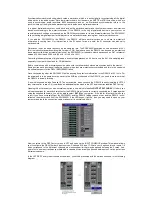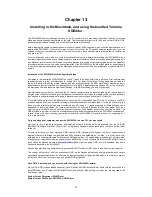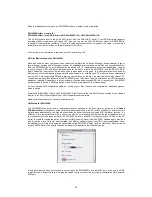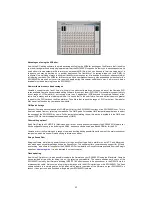
51
The other connectors on the top edge of the DS2416 are covered in detail in the DS2416 user manual. For the
purposes of this guide, we shall not go into too much detail but briefly mention that they are designed for the optional
AX44 and AX16AT units designed for the DS2416, and also for linking up 2 DS2416 cards together in tandem.
So when we open up our computer to fit the DS2416 card along side the SW1000XG it is important that you connect
the 2 cards together in the manner shown below, to allow them to communicate, and perform their magic together.
When you have done this, it is then time to visit our website again!
The DS2416 and SW1000XG are clever in that they use a common driver model. For Windows users Yamaha have
posted 3 versions of the common driver files which are designed for the various configurations that you, the user may
have. These are
1: A driver set for people who just use the SW1000XG
2: A driver set for people who just use the DS2416
3: A driver set for people who use the 2 cards cascaded
The latest versions of all of these can be found on our Pro Audio web site, and Xgfactory web site (drivers downloads
sections), or if you do not have net access can be obtained by calling your local Yamaha dealer, and asking for them.
For Macintosh users, there are again 3 options that cover the same configuration variations with ASIO.
The reason for the 3 versions is that the driver code optimisation priority for each version (even though they look very
similar with similar named files) will differ based upon the configuration you own. With one driver optimised around
the DS2416, one around just the SW, and one designed for both cards at once. So once you have updated your
driver to work with your new 2-card setup, it is time to see what you can do, and how to get the 2 working together.
Yamaha’s decision to not include any software support other than a basic MIXTEST application with the DS2416
card was one that initially caused many people confusion. How did one get at all of the available power on the card?
Yamaha had come to an agreement with several third party software companies including Steinberg, Emagic,
Cakewalk, Cmexx and Musicator that they would supply the software support for DS2416 based around the software
development kit that Yamaha provided. Whilst graphically the software support looked different from application to
application, fundamentally they all did the same kind of thing. We shall focus on 1 application in this chapter, that
being Steinberg Cubase VST24. This is solely due to the software being a clear example of how to use the linkup
between the 2 cards. The methodology and terms used however can be applied to any of the applications that
support the DS2416.
The internal connector, which we shall refer to as SI (Serial Interconnect) between the 2 cards is capable of carrying
up to 8 discreet digital channels or either MIDI or audio to 8 discreet mixer channels of the DS2416 card. The
DS2416 card has the ability to bring in audio from many sources, such as the AX44 expansion bay or its own digital
inputs or analogue inputs, however, one of its cleverest functions is the SI option.
The SI connector can also carry wordclock information between the 2 cards to maintain synchronisation. It would now
be a good point to discuss what wordclock is, and why it is essential.
Unlike analogue audio equipment, digital audio equipment must be synchronised when digital audio is transferred
from one device to another, otherwise, the digital audio might not be read correctly and audible noise, glitches, or
clicking may occur.
















































